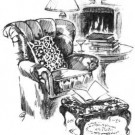I Hate Cozies!

Like many mystery readers, what I like best in the whole world is to curl up in a comfy chair in front a fireplace with a book in which I can lose myself for hours and hours; a book that is fast-paced and fun, full of odd characters and unexpected events; a book that challenges me and takes me to places that I might not dare go in real life, but doesn’t leave me afterwards wanting to stick my head in an oven or feeling like I need a shower.
If you had to come up with one word that captured the essence of this kind of book, what would it be? Perhaps “cozy” might fit the bill, but to many publishers and booksellers the word “cozy” connotes a mystery filled with cats and little old ladies drinking tea. It also says “this kind of book has a very small audience.”
I was a panelist recently at an MWA event in New York where I live, and a member of the audience, apologizing for her naiveté, asked the question. “What is a cozy?”
The True Crime lady was happy to pipe up with something to the effect of “Oh, that’s where you have an amateur detective and she — it’s practically always a she — has some neighbor murdered and she takes it upon herself to INVESTIGATE because the police are always incredibly stupid and there’s no violence, but there are always lots of cats, and everyone sits around and drinks tea.”
Who the hell would want to read such a thing? Or write such a thing? Even Agatha Christie, who probably is the prototypical cozy author, never did.
The fact is that all of us, authors, editors and readers alike, are prisoners of mystery categories. And if it’s not a Private Detective, a Police Procedural, a Historical or a Noir, increasingly often it’s being lumped into the Cozy bin. I’ve seen everyone from Lawrence Block to Sujata Massey referred to as “cozies” and this is just crazy. The cozy catch-all is like the bed of Procrustes, a bandit of Greek myth who invited his victims to have a lie down. If they were too big to fit on the bed, he cut off their feet. If they were too short, he stretched them.
Naturally publishers and booksellers need some kind of categories in order to steer customers to the kind of books they might like. “Mystery” itself is a category. However, the deck is getting stacked against the sub-genre of cozies. It doesn’t matter if a writer has never included a cat or a cup of tea in his books (and I have nothing against cats or tea, believe me). The problem is that once he’s lumped into the Cozy category he’s increasingly likely to have his contract cancelled because publishers think “cozies” aren’t profitable — or worse, that they’re not important and macho enough for their big important house.
IF NOT COZIES, THEN WHAT?
I’ve made the case for the term “Maverick” — at least for my own work, which doesn’t really fit any of the current terminology. However, the real categories of all books, mysteries included, are still the ones I learned when I was studying playwriting: comedy, tragedy, melodrama and farce. Within these categories I — and every other writer — fits nicely. I happen to write comedy — not the funny, ha-ha kind, but the form in which the ground falls out from under you at the end and plunges the level of discourse in a celebration of life. I recognize that some mysteries are crafted as tragedies, and some as farce, but the vast majority today are simply melodramas.
Aristotle identified various elements that a good story has to have. You could go from the lowest — spectacle — up through words and music, to plot, then to character, and finally to thought. The vast majorities of mysteries today do not fit into any of these areas. They are, plain and simple, melodramas, the form that has always been the most popular with the masses. There is no catharsis of pity and fear here, and no celebration when order returns (as it does in comedy) from chaos. There is simply a thrill a minute. Pauline is tied to the railroad tracks. We gasp. She’s saved at the last minute. We breathe a sigh of relief. But then the villain carries her off again. The curve of the action takes place not in the story or the thought, but in the audience’s emotions.
Serial killer books are the logical conclusion of this form, a genre which is entirely about eliciting strong emotions in the reader. It is the addicts of this emotional fix — and of course the horror that is encountered has to be ratcheted up in each book until you have children being skinned alive and other excesses worthy of the end of the Roman Empire, which is where the genre is today in my opinion — it is these people who have invented the word “cozy” and made it a pejorative term. Who could possibly care about some little old lady solving crimes and drinking tea when there are children being abused, women being raped, good men being killed in the most horrible fashion imaginable ( — all in the name of selling books)?
The fact is, however, that redemption and the return of the moral center is more likely to come from a well-crafted classical comedy with integrity than from the final, last minute destruction of the most hideous serial killer imaginable. That’s why Classical Comedy is what I try to write. But try selling it as that!

